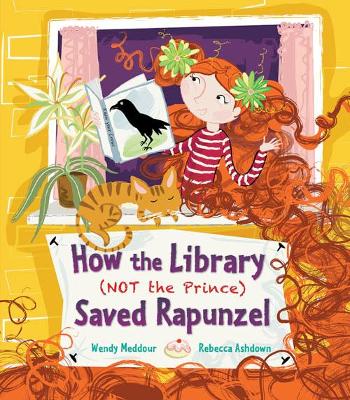
Jo
4.5 Stars.
The title of this book alone had me really intrigued. I was sensing a possible feminist fairy tale retelling, and that was exactly what I got, but so much more. How the Library (Not the Prince) Saved Rapunzel by Wendy Meddour & Rebecca Ashdown is a fantastic picture book, with all kinds of wonderful messages.
Rapunzel sits high up in the tower block where she lives, alone and miserable. Those who visit her try to help, but they don't seem to be able to reach her, she just stares out the window. Not even the Prince has any affect on her. When she finally opens a letter the postman delivers, everything changes. It's come from the library, and they have some important news that gets her smiling again!
How the Library is a book that promotes a good work ethic, with the idea that having a purpose is the key to a happy life. The letter Rapunzel receives is a job offer from the library, and now Rapunzel has some meaning to her life, she is back to her happy, sunny self again. Rapunzel doesn't need a man, she needs something to do.
It also seems to touch on mental health. Rapunzel is morose and despondent. She had "nowhere to go," "nothing to prove," "nothing to say," and "nothing to think". She won't eat, she won't leave the house, she won't talk to anyone, until her friends - the milkman, the postman, the baker and her auntie - orchestrate an intervention.
The lift had broken down, and no-one really wanted to climb all the stairs due to ill-health, but seeing how Rapunzel has shut herself off from the world in the tower - her almost self-imposed imprisonment - they realise they have to do more to help her, and they climb the stairs to her flat. They cook her some food and get her to eat, and are just there for her. And when she reads the letter, it's the one good thing she needs that turns her life around.
From page 12 of How the Library (Not the Prince) Saved Rapunzel
by Wendy Meddour & Rebecca Ashdown.
Ashdown has down a wonderful job of making How the Library a really diverse book with her illustrations, which is so wonderful to see. Not just in the characters who visit Rapunzel, but in the people out and about near the tower block. The Prince, who appears only briefly, is a person of colour, which is just brilliant - he's modern and trendy too!
From page 10 of How the Library (Not the Prince) Saved Rapunzel
by Wendy Meddour & Rebecca Ashdown.
And this is probably not as important as all the other things How the Library covers, but it's so pro-libraries and reading! Not only does the library give Rapunzel a job, but she gets to read so many books and she learns so many things! One of the parting messages encourages girls to be more concerned with books than boys.
'So don't wait for your prince to show.
He might turn up, but you never know.
Pop down to your library and borrow a book -
there's SO MUCH to find out if only you look. (p25)
From page 17 of How the Library (Not the Prince) Saved Rapunzel
by Wendy Meddour & Rebecca Ashdown.
Although this book is mostly pretty feminist, there are two ideas in How the Library that I find partially problematic. Once Rapunzel has read the letter and is happy again, she fixes the lift "in a ladylike manner!" (p17). I'm all for the idea that girls can fix things as well as boys, but I winced a little at how Rapunzel was "ladylike" while she fixed it. It's a small thing, but it perpetuates the idea that there is a "girlish" / "ladylike" way of doing things, and that there is a "boyish" way, and girls should be "ladylike". It's almost a mixed message; yes, girls can do things that are stereotypically things boys do, but only if they're ladylike while they do them. I know "manner" rhymes with "spanner", but I do wish they managed to make it rhyme without this idea.
Also, when her friends make it up to her flat, they find Rapunzel "sat alone with only her cats" (p14). Again, cats rhyme with flat, I get that, but it's the cat lady idea. The book might be saying girls don't need boys to have a full life, but still, without them, girls are alone with their cats. It feeds in to the stereotype, I think.
From page 14 of How the Library (Not the Prince) Saved Rapunzel
by Wendy Meddour & Rebecca Ashdown.
As I said, these are only small things. The book on the whole really is brilliant, with it's great message and by challenging gender roles, and would make a wonderful addition to child's feminist library.
Thank you to Frances Lincoln for the review copy.
